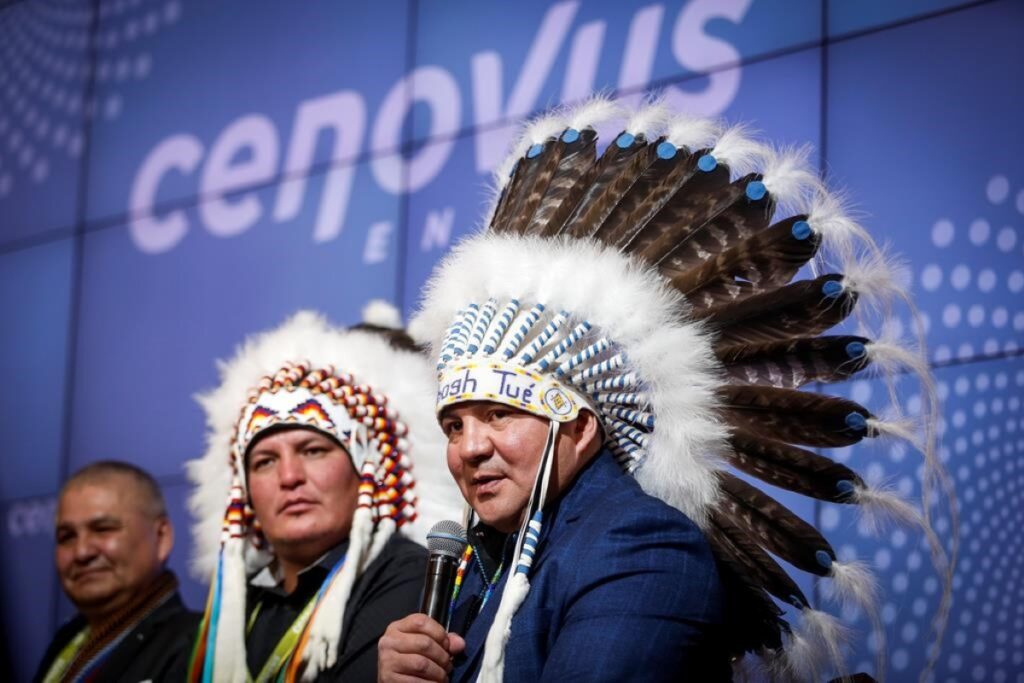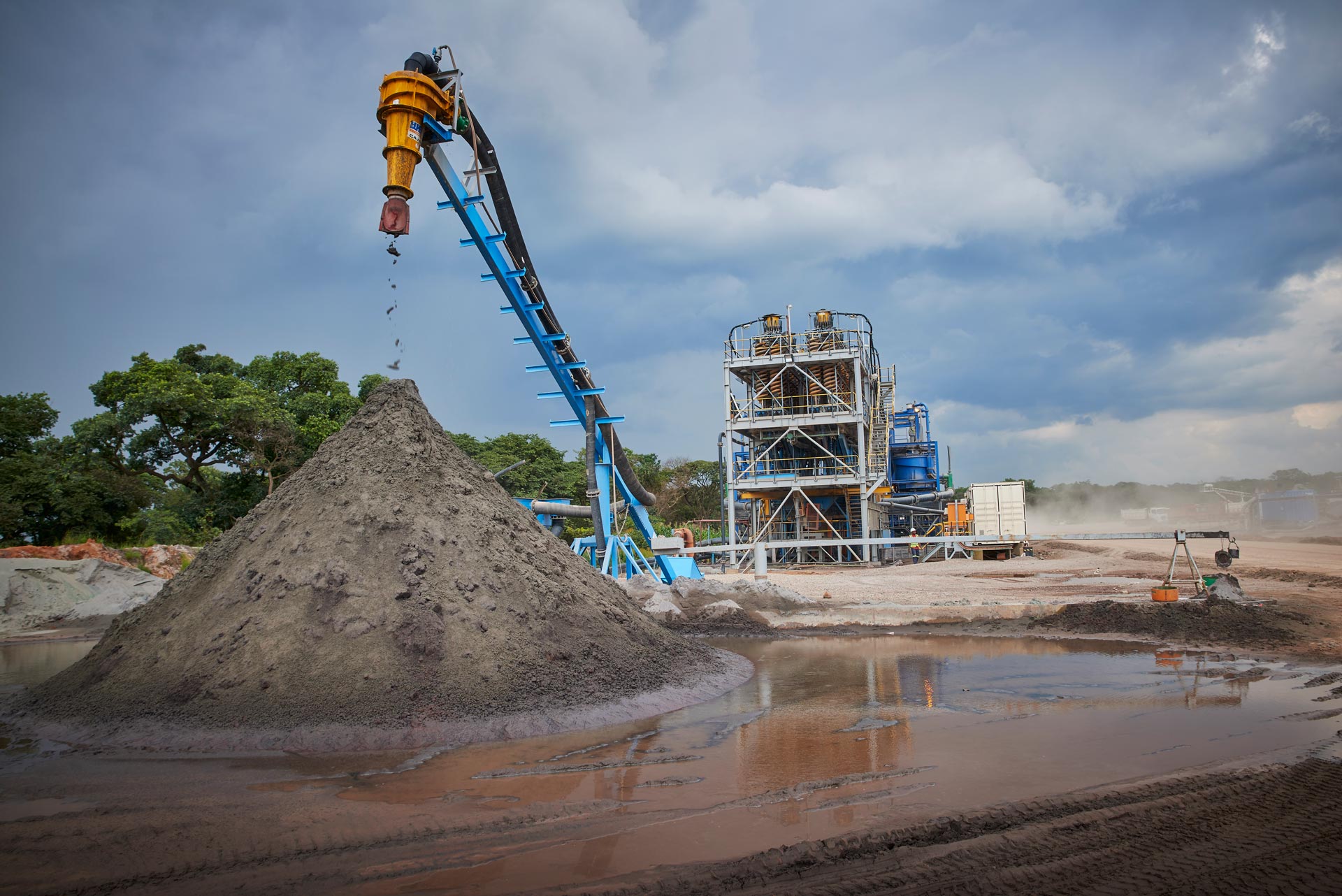A federally guaranteed Indigenous loan program is reconciliation progress, but only if it respects Indigenous agency.

Roger Marten, right, Chief of Cold Lake First Nations, and Curtis Monias, centre, Chief of Heart Lake First Nation, speak after Cenovus CEO Alex Pourbaix announces an initiative focused on Indigenous communities. Photo from The Canadian Press.
By Resource Works
More News and Views From Resource Works Here
Indigenous communities are increasingly becoming partners and owners in major natural resource projects across the country.
Resource Works has been excited to be involved in that movement through our annual Indigenous Partnerships Success Showcase, where we convene Indigenous experts to discuss Indigenous partnerships in major projects and across the Canadian economy.
Under a proposed federal program, even more, Indigenous communities could become partners and even owners in major natural resource projects, from oil to natural gas and liquified natural gas (LNG).
Back in 2010, the proposed Northern Gateway oil pipeline from Alberta to Kitimat offered a 10% equity stake in the project to participating Indigenous groups. Yet despite having significant support, there was also considerable Indigenous opposition to the project. Ultimately, the project was killed when Prime Minister Trudeau banned oil tanker traffic on BC’s northern coast.
Fast forward twelve years, and the Coastal GasLink (CGL) natural gas pipeline and the LNG Canada project are nearing completion. In fact, CGL finished laying the last of its pipe in the ground in October 2023, completing a truly herculean engineering task, the first energy pipeline to the coast in decades. Despite some Indigenous opposition, CGL has the support of the elected councils of all 20 First Nations along the route and has offered an option for First Nations to purchase a 10% equity share in the pipeline.
Coastal GasLink will feed LNG Canada, the largest private sector investment in Canadian history. That project will turn CGL’s natural gas into liquid, where it can be shipped more densely to Asia to help replace coal, especially in industrial applications, and reduce global carbon emissions.
While CGL and LNG Canada near completion, two more proposals for LNG projects in BC are coming onto the scene. A historic first, these projects are led by First Nations: the Cedar LNG project near Kitimat from the Haisla Nation and Ksi Lisims LNG in Northern BC from the Nisga’a Nation.
A third LNG project, Woodfibre LNG, was approved by the Squamish Nation in the first-ever Indigenous environmental impact review and is now beginning construction.
Indigenous involvement – and leadership – in major energy projects has arrived. Indigenous LNG is Canadian LNG, and Canadian LNG has become Indigenous LNG. This is a global first.
Beyond natural gas and LNG, the Trans Mountain oil pipeline expansion project from Alberta to Burnaby is anticipating completion in March 2024. The expansion triples the pipeline’s capacity, the only oil pipeline to Canada’s West coast.
While there has been Indigenous opposition to this project, there has also been support, including formal agreements and billions in contracting deals for Indigenous businesses during construction. In fact, several Indigenous groups are working to acquire an equity stake in the pipeline.
Historic restrictions in the Indian Act mean Indigenous peoples face enormous barriers in raising or borrowing money to finance equity partnerships. Yet the ability to purchase equity in major projects is to enter the big leagues of economic development and wealth generation.
The federal government is expected to announce a guaranteed loan program that will enable Indigenous Peoples to finally bypass these structural obstacles and purchase equity shares in resource projects. Alberta and Saskatchewan already have their own programs, and the federal government has a lot to learn from them, particularly Alberta’s Alberta Indigenous Opportunities Corporation.
Supporters of such programs point out that Ottawa, without spending a cent of taxpayers’ money, could backstop loans to Indigenous communities. It’s a low-risk mechanism and another way to support economic reconciliation.
Unfortunately, there is uncertainty about whether this federal initiative will allow all projects to be supported. There are reports that Ottawa will exclude oil and gas projects from the guaranteed-loan program, in favour of exclusively renewable and green energy projects.
Indigenous groups argue that they can make up their own minds on what to invest in.
Four Indigenous groups have told the prime minister: “This program cannot be driven by an ‘Ottawa-knows-best’ policy approach – the judgement of Indigenous Nations about projects to pursue must be respected. . . . We believe that this initiative is not only a practical step towards reconciliation but an opportunity to demonstrate Canada’s commitment to a just future for First Peoples.”
If this loan program is created, it should be up to Indigenous peoples to decide what they want to get involved in. If we are in an era of reconciliation, shouldn’t we empower Indigenous Peoples to be decision-makers?
We can do big things as a country when we partner with Indigenous peoples. But we need to ground our policies in a positive framework that builds agency.
For many Indigenous peoples, that starts with charting their own economic destiny, including in natural resources.
Margareta Dovgal is Resource Works’ Managing Director and Event Lead for the Indigenous Partnerships Success Showcase.
Share This:



